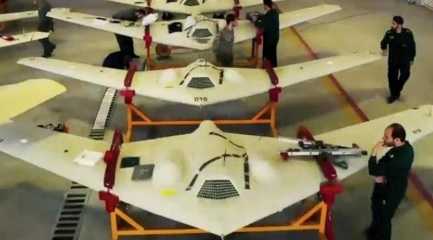
18 Apr 2023; MEMO: In a show of strength, Iran's military put an array of weapons systems, including indigenously developed drones, on display Tuesday at a parade in Tehran to mark the National Army Day, Anadolu News Agency reports.
The parade, attended by top political and military leaders, included units from the Army's ground force, navy and air force and the presentation of fighter jets, helicopters, missiles and drones.
More than 40 classes of fighter jets, including Saeqeh, Kowsar, F-7, F-14, MiG-29 and Sukhoi jets and bombers performed aerial manoeuvres during the parade.
The displayed drones included Mohajer-6, Mohajer-4, Mohajer-2, Raad-85, Arash, Ababil-4, Ababil-5, Yasir, Karrar, Kian-1, Kian-2, Omid, Kaman-12, Kaman- 22 and Sadeq, as per state media.
Mohajer-6, a single-engine multi-purpose drone, is capable of carrying a multispectral surveillance payload of up to four precision-guided munitions, according to military experts.
Kaman-22, the country's first wide-bodied unmanned combat drone, has a range of 3,000 kilometres and is capable of carrying up to 300 kilograms of explosives.
Raad-85 is a remotely piloted suicide drone designed for electronic warfare, while Arash is a suicide and anti-radar drone known to have the longest range among suicide drones possessed by Iran.
Like Mohajer, Ababil is a single-engine combat reconnaissance drone equipped with bombs and missiles. Yasir is a light tactical surveillance drone and Karrar is a jet-powered recce and attack drone.
Kian, unveiled in September 2019, is an unmanned drone that can travel more than 1,000 km, while Omid, similar to the Israeli Harop drone, was seen in action for the first time in last year's annual Army parade. Sadeq is a combat drone that was first unveiled in April 2016.
Among the indigenous missile systems displayed during Tuesday's parade include Damavand, which is capable of intercepting and destroying various types of aircraft as well as cruise and ballistic missiles.
Addressing the parade on Tuesday, President Ebrahim Raisi warned that any "slightest action" by Israel against his country would see "the destruction of Haifa and Tel Aviv".
He said the Army Day sends a "message of peace and friendship for countries in the region," but warns that "extra-regional forces" must leave the region "as soon as possible," referring to the US.
This year's military parade came amid Iran's growing tensions with both the US and Israel, amid a stalemate in the 2015 nuclear deal talks and recent strikes targeting IRGC members in Syria.
Facing Western developed sanctions, Iran has, in recent years, the capability to produce its own weapons systems, making significant progress, particularly in the drone industry.
In January, Iran's armed forces held large-scale military drills in the country's waters, using home-grown drones including Arash, Bavar and Ababil to hit simulated targets at the sea coast.
Reconnaissance and combat drones, including Mohajer-6, were used to survey simulated war zones and collect and transmit intelligence and topographic images to the joint control command centre.
The drills came after Iran's top military General, Mohammad Bagheri, said the country is determined to strengthen its drone industry and cooperate with other countries in manufacturing them.




